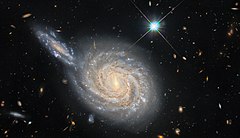NGC 105
(c) Credit: ESA/Hubble & NASA, D. Jones, A. Riess et al. Acknowledgement: R. Colombari, CC BY 4.0NGC 105 (HST) | |
| Odkrywca | |
|---|---|
| Data odkrycia | 15 października 1884 |
| Dane obserwacyjne (J2000) | |
| Gwiazdozbiór | |
| Typ | spiralna (Sab) |
| Rektascensja | 00h 25m 16,9s |
| Deklinacja | +12° 53′ 01″ |
| Przesunięcie ku czerwieni | 0,017285[1] |
| Jasność obserwowana | 13,1m |
| Rozmiary kątowe | 1,1' × 0,7' |
| Alternatywne oznaczenia | |
| PGC 1583, UGC 241, MCG 2-2-8, ZWG 434.9, IRAS00226+1236 | |
NGC 105 (również PGC 1583 lub UGC 241) – galaktyka spiralna (Sab), znajdująca się w gwiazdozbiorze Ryb. Odkrył ją Édouard Jean-Marie Stephan 15 października 1884 roku[2].
Do tej pory w galaktyce zaobserwowano dwie supernowe[3]:
- SN 1997cw, odkryta 10 lipca 1997 roku, osiągnęła jasność obserwowaną 16,5m.
- SN 2007A, odkryta 2 stycznia 2007 roku, typ Ia, osiągnęła jasność obserwowaną 16m.
Zobacz też
Przypisy
Linki zewnętrzne
- NGC 105 w serwisie SEDS.org (Revised NGC and IC Catalog) (ang.)
- NGC 105 w bazie SIMBAD (ang.)
- NGC 105 w NASA/IPAC Extragalactic Database (ang.)
Media użyte na tej stronie
(c) Credit:
ESA/Hubble & NASA, D. Jones, A. Riess et al.
Acknowledgement: R. Colombari, CC BY 4.0Galactic Conjunction
This image from the NASA/ESA Hubble Space Telescope captures the spiral galaxy NGC 105, which lies roughly 215 million light-years away in the constellation Pisces. While it looks like NGC 105 is plunging edge-on into a collision with a neighbouring galaxy, this is just the result of the chance alignment of the two objects in the night sky. NGC 105’s elongated neighbour is actually far more distant and remains relatively unknown to astronomers. These misleading conjunctions occur frequently in astronomy — for example, the stars in constellations are at vastly different distances from Earth, and only appear to form patterns thanks to the chance alignment of their component stars.
The Wide Field Camera 3 observations in this image are from a vast collection of Hubble measurements examining nearby galaxies which contain two fascinating astronomical phenomena — Cepheid variables and cataclysmic supernova explosions. Whilst these two phenomena may appear to be unrelated — one is a peculiar class of pulsating stars and the other is the explosion caused by the catastrophic final throes of a massive star’s life — they are both used by astronomers for a very particular purpose: measuring the vast distances to astronomical objects. Both Cepheids and supernovae have very predictable luminosities, meaning that astronomers can tell precisely how bright they are. By measuring how bright they appear when observed from Earth, these “standard candles” can provide reliable distance measurements. NGC 105 contains both supernovae and Cepheid variables, giving astronomers a valuable opportunity to calibrate the two distance measurement techniques against one another.
Astronomers recently carefully analysed the distances to a sample of galaxies including NGC 105 to measure how fast the Universe is expanding — a value known as the Hubble constant. Their results don’t agree with the predictions of the most widely-accepted cosmological model, and their analysis shows that there is only a 1-in-a-million chance that this discrepancy was caused by measurement errors. This discrepancy between galaxy measurements and cosmological predictions has been a long-standing source of consternation for astronomers, and these recent findings provide persuasive new evidence that something is either wrong or lacking in our standard model of cosmology.
Credit:
ESA/Hubble & NASA, D. Jones, A. Riess et al. Acknowledgement: R. Colombari
.
